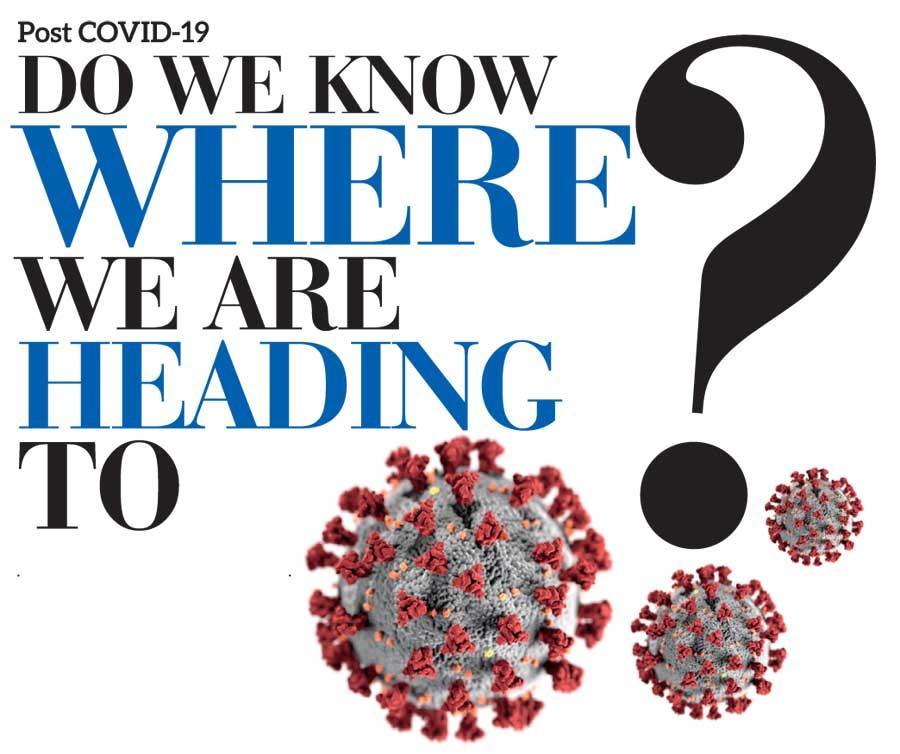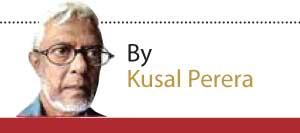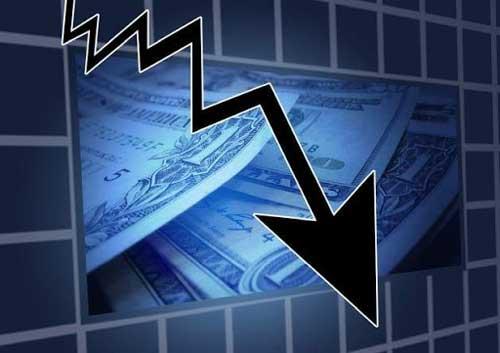Reply To:
Name - Reply Comment

Can we get back to normal social and economic life that we had, before COVID-19 shattered it beyond shape? Or should we at all? Urban middle-class in general expect they can get back to their usual life, once COVID-19 outbreak is under control and the curfew removed. Eager to have their usual life as early as possible, they often tend to pick little quarrels with the government on daily issues. Some do not want the government to impose complete lockdown that keeps them indoors 24x7 continuously, as in Western Province. Some do not want the government to provide intervals in-between curfew days, saying it allows for breakdown of “social distancing” and dragging the situation further down. Some want a regulated lockdown so they could attend to their daily work. It is no easy task to pickle all solutions into one single package of COVID-19 prevention.
This uncertainty in how to control the ‘novel’ Coronavirus from spreading across national boundaries in numerous ways with controversy over new mutations leading to more aggressive strains, left countries with ‘trial and error’ efforts. Meanwhile the ‘Global Economy’ began crumbling down at high speed. After over 40 plus years when the  ‘global village’ was bundled into a single briefcase of the giant corporate sector with high speed IT communication and then after a slow recovery from the 2008 meltdown, there was no guess of another recession in a decade or two to come.
‘global village’ was bundled into a single briefcase of the giant corporate sector with high speed IT communication and then after a slow recovery from the 2008 meltdown, there was no guess of another recession in a decade or two to come.
Neo liberalism as a global economy left both the investor and the producer dependent on a supplier of raw materials and a fast-growing urban middle-class market. There were middle-men along the route no doubt. None could profit without the other stakeholders and the consumer. Export oriented Indian mega pharmaceutical industry is one story about that dependence.They were wholly dependent on Chinese ‘Active Pharmaceutical Ingredients’ (API) for formulation of Western drugs. All pharmaceutical products in India came to be totally based on Chinese APIs by late 1990s. They were sold in the world market as ‘made in India’. COVID-19 left the whole industry devastated, with Chinese APIs unable to be imported into India.
"Neo liberalism as a global economy left both the investor and the producer dependent on a supplier of raw materials and a fast-growing urban middle-class market"
There were other products originated in the US and in EU that monopolised the global consumer market as prestigious ‘brands’ that in Colombo counts L’OREAL, Carlsberg, Nike, Calvin Kline and more, also similarly devastated. The total apparel industry in Sri Lanka was dependent on EU and US markets and almost wholly on Chinese raw materials. SL apparels cannot survive without China and without US and EU markets. Both raw materials from China and the markets in US and EU unavailable, SL apparel industry is in serious trouble.
What COVID-19 did was to dissemble this whole global economic process. Lockdowns and curfew closed consumer markets in US, EU and in other wealthy countries. Each nation is now grappling to fix the pandemic on its own, within its boundaries. This was stressed by Elizabeth C. Economy, Senior Fellow and Director for Asia Studies, Council on Foreign Relations (CFR), quoted in the New York Times on 16 April. It was said with reference to the US and the EU, there could be more likely a greater degree of domestic production and stockpiling, introduce a greater degree of self-sufficiency than supply chain diversification and redundancy.
In short, COVID-19 has pushed us to the wall to find alternate answers to all socio-economic issues within our national economy that was wholly ignored. What then is our option? One is to go ‘China’. To see what could be copied from China for post COVID-19 national development. On a conference call discussion organised by the CFR on 16 April, Brad W. Setser, Senior Fellow for International Economics at CFR said, on what IMF has forecasted for China in 2020, it will have a positive growth whole year through despite a contraction of 05 percent year on year.
China is not in a post COVID-19 situation as yet, but there is much to be picked up on the economic front from what Setser had to say about ‘export dependency’. He said (quote) “Well, I think if any country knows a little bit about reducing industrial dependence on the rest of the world through conscious policies, that country would be China. I mean, China’s had an industrial self-sufficiency policy called ‘China 2025’ in place for several years, and I think it has already had an effect on China’s economy. China is less export dependent now than it was five years ago, or ten years ago. So, in many ways, other countries will be moving, in some sense, towards a more Chinese approach to national industrial self-sufficiency” (unquote).
"Both raw materials from China and the markets in US and EU unavailable, SL apparel industry is in serious trouble"
This immediately would be taken as the pre 1977 ‘closed-door economy’ of Madam Bandaranayake’s coalition government with the traditional ‘Left’, the Sama Samaja and the Communist parties. That period was branded by the Jayawardene election campaign in 1977 as the ‘polim yugaya’ (era of queues). ‘Closed-door economy’ being  an extremely centralised State intervention in economic planning and implementing, Sri Lanka was taken to the other extreme end of unplanned and unrestricted import-export trade in an open market post 1977, with the State used as a ‘facilitator’.
an extremely centralised State intervention in economic planning and implementing, Sri Lanka was taken to the other extreme end of unplanned and unrestricted import-export trade in an open market post 1977, with the State used as a ‘facilitator’.
What is not being said and not been socially discussed is that, ‘national development’ was never defined and was never possible in this ‘free for the rich trade economy’ that left out the whole rural society as cheap labour for export manufacture. All Sri Lankan governments since 1977 provided infrastructure, tax benefits, tax waivers and holidays at the expense of the public to private sector manufacture while they had no say in deciding what should be manufactured. That was decided by foreign investors on what profits they could earn in the shortest possible time, on minimum investments made. Nothing was planned and nothing could be planned for the local market within this investor dominant free market and the rural economy was not even thought of as a necessary segment in the national economy. This ‘rural emptiness’ became agonisingly apparent and far heavier than ever thought of, no sooner the curfew was imposed on 20 March. The daily income earning ‘informal sector’ in Colombo and its suburbs that comprised of at least a million domestic migrants from villages and the plantation sector, were immediately thrown out of ‘city living’ with curfew imposed.
Considered the second wealthiest country in the South Asian region next to Maldives in 2017 and lifted to the ‘middle income’ category, we are now told, Sri Lanka is one of the worst COVID-19 affected countries. ‘The Economist’ from Landon said, based on public debt, public and private foreign debt, borrowing cost and reserve cover, Sri Lanka was ranked at 61 out of 66 worst affected countries, only being better than Angola, Bahrain, Zambia, Lebanon and Venezuela.
"Lockdowns and curfew closed consumer markets in US, EU and in other wealthy countries. Each nation is now grappling to fix the pandemic on its own, within its boundaries"
We now have to accept that all ‘numbers’ played out to live on ‘export manufacture dependency’ had been a total farce that was exposed by COVID-19 within a few weeks. Large scale private sector employers who were boasting they were bringing in dollar incomes to the country with their exports, suddenly claim they cannot even pay salaries for their own employees. They want the government to bail them out.Their export manufacture income could not even cut square with import cost and left us with a public debt of 79 percent of the GDP in 2017. There is no way anymore to expect the city based free market economy with export manufacturers who cannot even sustain their workforce for 03 months, to lift Sri Lanka out of this massive crisis.
For that reason alone, we are now compelled to move to a different economic model that gives priority to ‘an industrial self-sufficiency policy’ that includes diversification of agriculture and value addition. An economic policy that would virtually stop import of vehicles and have serious controls on import of non-essential goods. We would thus have to think of a novel model that accommodates a regulated market economy with a regional perspective. One that would look towards multi-lateral development initiatives with SAARC countries. That would also raise the issue of governance and that of a new Constitution drafted with direct people’s participation. Regionally, SAARC itself will have to re-think its future in a post COVID-19 world. It would be a challenge, COVID-19 will not allow us to ignore and by-pass.